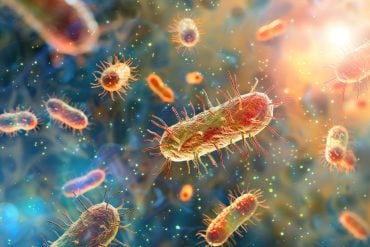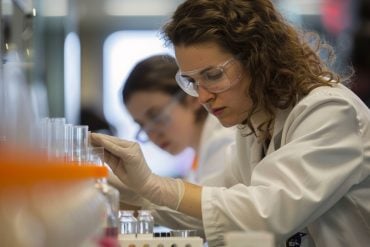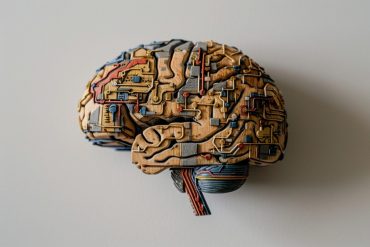Summary: A new study reveals that a single gene may be linked to some cases of ASD.
Source: Washington University.
Findings could provide clues about other genes involved in autism.
Scientists have linked mutations in a single gene to autism in people who have a rare tumor syndrome typically diagnosed in childhood.
The findings, in patients with neurofibromatosis type 1 (NF1), may lead to a better understanding of the genetic roots of autism in the wider population.
The findings are published Oct. 19 in the journal JAMA Psychiatry.
Studying 531 patients at six clinical centers in the United States, Belgium, the United Kingdom and Australia, the researchers found that mutations in the NF1 gene that cause the disease also contributed to autistic behaviors in almost half of the patients.
“NF1 is caused by mutations in a single gene — NF1,” said first author Stephanie M. Morris, MD, an instructor in neurology. “Our research indicates that this single gene also is associated with autism spectrum disorders in these same patients. That may make it possible to look downstream from the gene to find common pathways that contribute to autism in the wider population.”
NF1, the disorder caused by NF1 mutations, usually appears during childhood. Symptoms can vary in severity, but they include café au lait spots, which are flat, brown spots on the skin. Other symptoms include tiny nodules on the iris of the eye, nerve tumors, bone deformities such as a curved spine or a bowed lower leg, and optic gliomas, tumors of the optic nerve. Kids with NF1 also can have learning disabilities.
“In the 25-plus years that I’ve taken care of kids with NF1, we’ve only recently started to recognize that these children also often have symptoms of autism,” said senior investigator David H. Gutmann, MD, PhD, the Donald O. Schnuck Family Professor of Neurology and director of the Washington University NF Center. “In the past, we didn’t really understand the association between NF1 and autism, but now we have new insights into the problem, which will allow us to design better treatments for children with NF1 and autism.”
The findings also could help scientists who study the genetics of autism understand how mutations in a single gene can contribute to symptoms of autism, such as problems with social and language skills and repetitive behaviors.
About 100,000 people in the United States have NF1. It is equally common in both sexes and in all ethnic groups. Autism, meanwhile, affects 1 percent to 2 percent of all children in the United States and is four to five times more common in boys than in girls.

“What’s unique about our findings is that it’s likely mutations in the NF1 gene are driving most of the symptoms of autism in children with NF1,” said the study’s other senior investigator, John N. Constantino, the Blanche F. Ittleson Professor of Psychiatry and Pediatrics and director of the William Greenleaf Eliot Division of Child & Adolescent Psychiatry. “Here, we have a single-gene disorder that affects a fairly large number of people and is causing autism in a significant number of those who are affected. This work could provide us with an opportunity to study a single gene and figure out what it is doing to cause autistic syndromes.”
Constantino said most autism spectrum disorders are influenced by multiple genes but that isolating this one gene can aid efforts to learn how other, unrelated genes may interact along that same pathway to contribute to autism in people who don’t have NF1.
Learning how those various genes come together to cause symptoms eventually could lead to better treatments. But already the findings are benefiting children and families treated at the Washington University NF Center.
“We’ve been able to screen children at our center, identify autism spectrum disorder, attention-deficit disorder and problems with executive cognitive function,” Morris said. “And when we identify these deficits in kids, we can tell their parents, inform their schools and enable these children to get the resources and support they need — specifically academic and social support – to improve their quality of life.”
Morris, SM, Acosta MR, Garg S, Green J, Huson S, Legius E, North KN, Payne JM, Plasschaert E, Frazier TW, Weiss LA, Zhang Y, Gutmann DH, Constantino JN, and the International NF1-ASD Consortium Team (INTACT). NF1 gene mutations engender the full spectrum of autism. JAMA Psychiatry. Oct. 19, 2016.
Funding: This work was supported by the Eunice Kennedy Shriver National Institute of Child Health & Human Development of the National Institutes of Health (NIH), grant number U54 HD087011. Additional funds came from Schnuck Markets, Inc., the Neurological Sciences Academic Development Award at Washington University School of Medicine, the NIH New Innovator Award 1DP2OD007449, and the Opening the Future grant of KU Leuven.
Source: Jim Dryden – Washington University
Image Source: NeuroscienceNews.com image is credited to Michael Worful.
Original Research: Full open access research for “Disease Burden and Symptom Structure of Autism in Neurofibromatosis Type 1: A Study of the International NF1-ASD Consortium Team (INFACT)” by Stephanie M. Morris, MD; Maria T. Acosta, MD; Shruti Garg, PhD; Jonathan Green, FRCPsych; Susan Huson, MD; Eric Legius, MD; Kathryn N. North, MD; Jonathan M. Payne, PhD; Ellen Plasschaert, PhD; Thomas W. Frazier, PhD; Lauren A. Weiss, PhD; Yi Zhang, MSc; David H. Gutmann, MD, PhD; John N. Constantino, MD in JAMA Psychiatry. Published online October 19 2016 doi:10.1001/jamapsychiatry.2016.2600
[cbtabs][cbtab title=”MLA”]Washington University. “Single Gene Linked to Some Cases of Autism.” NeuroscienceNews. NeuroscienceNews, 19 October 2016.
<https://neurosciencenews.com/genetics-autism-nf1-5311/>.[/cbtab][cbtab title=”APA”]Washington University. (2016, October 19). Single Gene Linked to Some Cases of Autism. NeuroscienceNews. Retrieved October 19, 2016 from https://neurosciencenews.com/genetics-autism-nf1-5311/[/cbtab][cbtab title=”Chicago”]Washington University. “Single Gene Linked to Some Cases of Autism.” https://neurosciencenews.com/genetics-autism-nf1-5311/ (accessed October 19, 2016).[/cbtab][/cbtabs]
Abstract
Disease Burden and Symptom Structure of Autism in Neurofibromatosis Type 1: A Study of the International NF1-ASD Consortium Team (INFACT)
Importance Recent reports have demonstrated a higher incidence of autism spectrum disorder (ASD) and substantially elevated autistic trait burden in individuals with neurofibromatosis type 1 (NF1). However, important discrepancies regarding the distribution of autistic traits, sex predominance, and association between ASD symptoms and attentional problems have emerged, and critical features of the ASD phenotype within NF1 have never been adequately explored. Establishing NF1 as a monogenic cause for ASD has important implications for affected patients and for future research focused on establishing convergent pathogenic mechanisms relevant to the potential treatment targets for ASD.
Objective To characterize the quantitative autistic trait (QAT) burden in a pooled NF1 data set.
Design, Setting, and Participants Anonymized, individual-level primary data were accumulated from 6 tertiary referral centers in the United States, Belgium, United Kingdom, and Australia. A total of 531 individuals recruited from NF1 clinical centers were included in the study.
Main Outcomes and Measures Distribution of ASD traits (Social Responsiveness Scale, second edition [SRS-2], with T scores of ≥75 associated with a categorical ASD diagnosis); attention-deficit/hyperactivity disorder (ADHD) traits (4 versions of Conners Rating Scale, with T scores of ≥65 indicating clinically significant ADHD symptoms); ASD symptom structure, latent structure, base rate derived from mixture modeling; and familiality.
Results Of the 531 patients included in the analysis, 247 were male (46.5%); median age was 11 years (range, 2.5-83.9) years. QAT scores were continuously distributed and pathologically shifted; 13.2% (95% CI, 10.3%-16.1%) of individuals scored within the most severe range (ie, above the first percentile of the general population distribution) in which the male to female ratio was markedly attenuated (1.6:1) relative to idiopathic ASD. Autistic symptoms in this NF1 cohort demonstrated a robust unitary factor structure, with the first principal component explaining 30.9% of the variance in SRS-2 scores, and a strong association with ADHD symptoms (r = 0.61). Within-family correlation for QAT burden (intraclass correlation coefficient, 0.73 in NF1-affected first-degree relatives) exceeded that observed in the general population and ASD family samples.
Conclusions and Relevance This study provides confirmation that the diversity of mutations that give rise to NF1 function as quantitative trait loci for ASD. Moreover, the within-family correlation implicates a high degree of mutational specificity for this associated phenotype. Clinicians should be alerted to the increased frequency of this disabling comorbidity, and the scientific community should be aware of the potential for this monogenic disorder to help elucidate the biological features of idiopathic autism.
“Disease Burden and Symptom Structure of Autism in Neurofibromatosis Type 1: A Study of the International NF1-ASD Consortium Team (INFACT)” by Stephanie M. Morris, MD; Maria T. Acosta, MD; Shruti Garg, PhD; Jonathan Green, FRCPsych; Susan Huson, MD; Eric Legius, MD; Kathryn N. North, MD; Jonathan M. Payne, PhD; Ellen Plasschaert, PhD; Thomas W. Frazier, PhD; Lauren A. Weiss, PhD; Yi Zhang, MSc; David H. Gutmann, MD, PhD; John N. Constantino, MD in JAMA Psychiatry. Published online October 19 2016 doi:10.1001/jamapsychiatry.2016.2600






